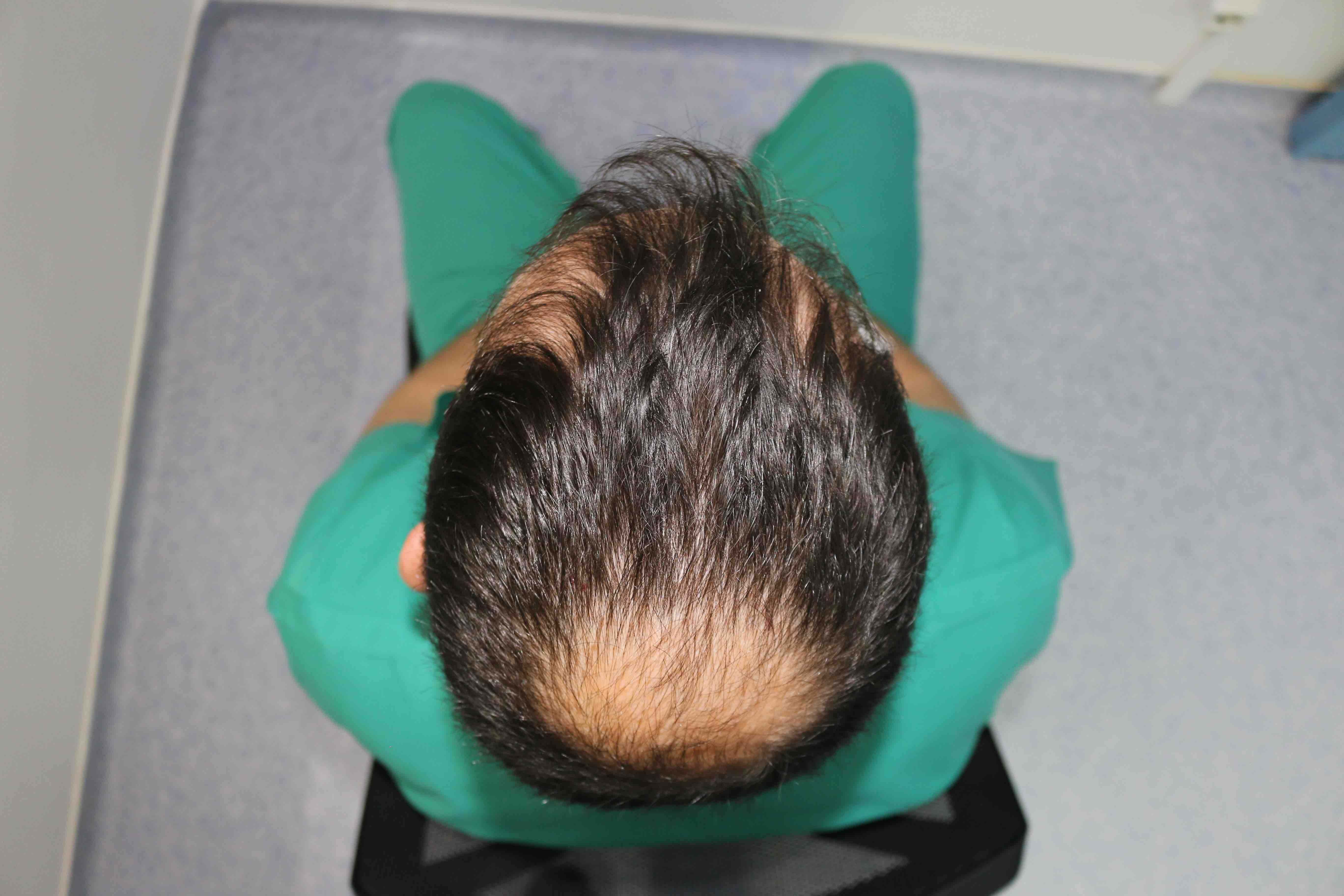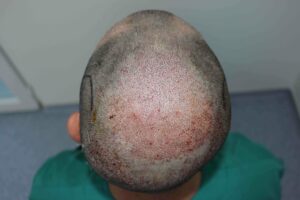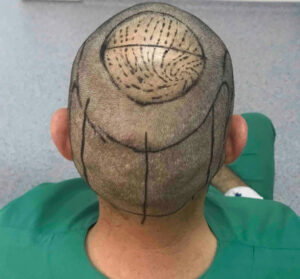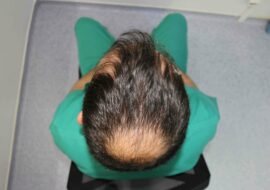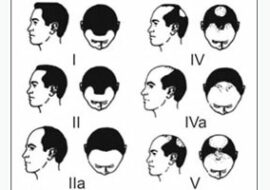Balding crown, the early signs
Hair loss on crowns: Therapies, medical approaches and hair transplant
Androgenic hair loss is a life-time process which does not occur instantly nor comes overnight but continuously proceeds and finally ends in a certain extent of alopecia. Visible signs of hair loss may often be noticed lately or at a higher age. It may also gradually be noticed by a daily glance into the mirror when unwillingly detecting thinning temples or a receding hairline. Hair loss may furthermore become evident on photos being taken over a certain period. A receding hairline and less volume with scalp hair actually reveal a process that has initially started years ago.
The process of hair loss
A regular and most common sign of progressive hair loss is a receding hairline on the human scalp. Starting with a noticeable thinning at the front and the temples genetic balding consistently proceeds to the crown. The process often lasts a lifetime to gradually result in a total balding of the scalp whereas in other types of men some hair will remain until the end of their days. Others may experience an early balding to rapidly show a high grade on the Norwood Scale due to a strong effluvium in younger ages.
Loosing hair does not necessarily involve inherited balding (androgenic alopecia). As with the human scalp loosing up to 100 hair per day the natural growth cycle of hair is not connected to genuine genetic hair loss since it regularly forces the follicles to fall out after a certain time. After a period of regular growing human hair turns into a resting phase until it forces the follicle to fall out. A few months later new hair will regrow at the same place. This effect is determined by the natural condition of human scalp hair. Finding a modest number of hairs on your pillow in the morning or after hair wash in the basin is no reason to be concerned or embarrassed about.
The regular pattern of hair loss is not the same with every human. Some experience a diffuse thinning or a significant balding around the tonsure, which regularly becomes evident with men. Over the course of many years this kind of hair loss can gradually proceed from the crown to the top until the hairline shows visible thinning or significant balding. Nevertheless hair loss at the crown does not remain without great embarrassment for those suffering from inherited balding.
Bald spots on the crown - Therapies
Luckily there is good news with limited hair loss on the crown: Modern medication has been found very effective against balding on the crown. Medical drugs are characterizing a simple and easy way to avoid hair transplantation and achieve significant success. If hair loss is limited to some balding spots on the crown or the back of the human scalp you may consult a dermatologist to examine your physical condition. In case he will determine inherited balding you may ask for medication against hair loss such as DHT-inhibiting hair shampoos, finasteride or minoxidil. Finasteride and minoxidil have particularly been proven very effective against hair loss at the back of the human scalp involving the vertex as they quickly help to cover the balding crown with regrowing hair with a majority of patients.
Furthermore medication also helps to significantly delay or stop hair loss. Since it is not easy to predict the individual extent of hair loss or the point when patients will experience visible balding spots on the crown a medical-drug-based approach will help to stop this process.
crown Hair Transplant
In case of progressive balding at the tonsure surgical hair transplantation involving the state-of-the-art method FUE at the HLC offers a promising method to successfully treat inherited balding (alopecia androgenetic). Every hair surgeon at our clinic has years of experience with hair transplant involving extensive balding on crowns. Being specified on hair transplantation with the modern FUE-method our clinic wants to inform every interested client about the possibilities and the limitations of hair transplant.
Hair density on crowns
As a matter of fact any hair transplant on the crown of the human scalp will regularly have excellent results in case the density of the final outcome corresponds to the natural hair density. This may require a density of about 70 grafts / cm² or up to cover the balding spots on the crown. But since the human donor supply is limited a density of 70 grafts/cm² is rather illusory since there will be no more donor hair left for future hair transplants.
Limited donor supply / Hair transplant on the crown
The larger the area to cover the more hair follicles (grafts) will be needed from the donor area of the patient to achieve an aesthetically pleasing result with hair transplants. Every patient should kindly be aware of the fact that the crown will not remain the only part on the human scalp to be affected by inherited balding. As described above, hair loss is continuously proceeding in varying degrees. As with most humans the hairline will regularly be affected by hair loss lately. This being said the HLC regularly recommends its patients to deliberately reduce their personal goals and requirements for a higher density on the crown. Successful hair restoration needs a conceptional donor management involving an appropriate density to economically cover both the crown and further parts of the scalp.
Hair transplant on the crown remains a delicate procedure since the angle of the grafts (hair follicles) to be placed is considerably lower than around other areas. Only experienced hair surgeons will be able to relocate the grafts properly. In addition, the vertex offers a hair swirl being of different structure and form with every human. Any hair transplant on the crown would basically require more hair follicles to achieve a higher density than at other areas.
Please take note of our patient, who - with an expected status 6 on the Noorwood Scale – hardly has enough donor supply to cover the entire scalp. This is why only a density of 30 grafts / cm² was chosen.
Natural and recommended densities / Personal desires vs reality
The HLC takes highest interest to fully meet the demands of our patients and visibly cover the whole crown with a total density of 50 grafts/cm² or more to result in a higher natural density. However, with many years of practice, it has been proven evident that patients regularly require more hair follicles to cover the recipient site due to progressive balding. As for the donor supply being strictly limited there are often not sufficient hair follicles available to perform future hair transplants due to an excessively chosen density for the crown. A few years after the procedure many patients see themselves being exposed to an unsatisfactory outcome on the head which can hardly be treated with further hair transplants.
Calculating the donor/recipient site
A satisfying outcome on hairlines involves a natural density of about 70 grafts/cm² to be delicately designed at the front of the patient. However, this remains a goal not being achieved regularly since hair loss proceeds or the patient´s donor supply is strictly limited. In any case a final density of 50 grafts/cm² determines the lower limit to be achieved at the hairline to result in an aesthetically pleasing outcome. Donor management and calculation is significantly needed due to the fact that miniaturization of hair will proceed with aging affecting both the balding area and the donor. Statistically, 40% of all men will achieve a state 3 on the Norwood Scale until the age of 59. This requires an average demand of 3500 grafts for the hairline.
If patients insisted in a voluminous density of 50 grafts/cm² and more to cover an extended balding on the crown the amount of hair follicles needed would be considerably higher and reach a total of 5,000 grafts (density: 50-100 grafts per cm²). It is rather obvious that most patients will not have this amount of grafts at their donor site to cover both the crown and the hairline by reaching a density this high.
Donor management for the crown - Recommendations of the HLC
As in social life the main focus is regularly lying on the hairline of a human whereas the vertex including the crown are mostly less visible for the human eye. More than 50% of our patients have been grateful to follow the recommendation of the HLC for a lower density on the crown since they have needed a higher density on the hairline. All these patients were open-minded for realistic solutions.
Due to the experience with numerous patients our hair surgeons regularly recommend a maximum density of 30 grafts/cm² to fully cover the tonsure as this allows for a consistently covered head from the back to the top. With a main focus on the crown a density of 30 grafts/cm² may sometimes appear slightly unsatisfactory to some patients. As for the total head involving future plans it regularly meets the expectations of a meaningful concept since a reasonable donor management will allow for aesthetically pleasing results on our patients´ head.
Additional methods for the crown
FUE (Follicular unit extraction) is the state-of-the-art method to achieve best results on patients with hair transplant. Hair restoration on the crown can effectively be used for further methods to achieve a visibly higher density including supplementary elements without wasting necessary donor supply.
Supplementary methods for the crown:
a) Body Hair Transplantation (BHT - Bodyhair Transplant)
Patients without sufficient donor supply may use body hair transplant to cover the crown with additional grafts taken from other parts of the body (beard, chest) and achieve a higher density. The HLC and its medical director Dr. Özgür have years of experience with BHT (body hair transplant) and are worldwide experts. Those who have a limited donor may benefit from this method to provide more grafts for the crown.
b) SMP Scalp Micropigmentation
SMP (Scalp Micropigmentation) is a very promising method to achieve the visual impression of hair and density. In addition to a hair transplant procedure on the crown, SMP may produce a natural density effect that eliminates the need for extra donor hair. The HLC is now offering SMP (Scalp Micropigmentation) both in Ankara/Turkey and Switzerland. Patients can benefit from this groundbreaking method in addition to hair transplant. As with a total of 30 grafts/cm² being used to cover the crown via hair transplant the final outcome can significantly be better with SMP as it achieves the visual effect of a higher density or even a fully covered crown. For more information about SMP please read here (link).




